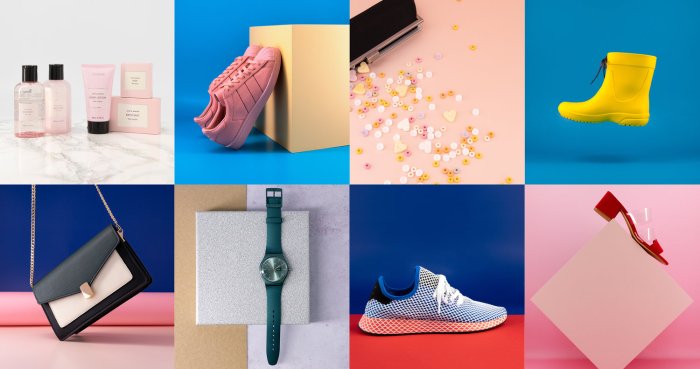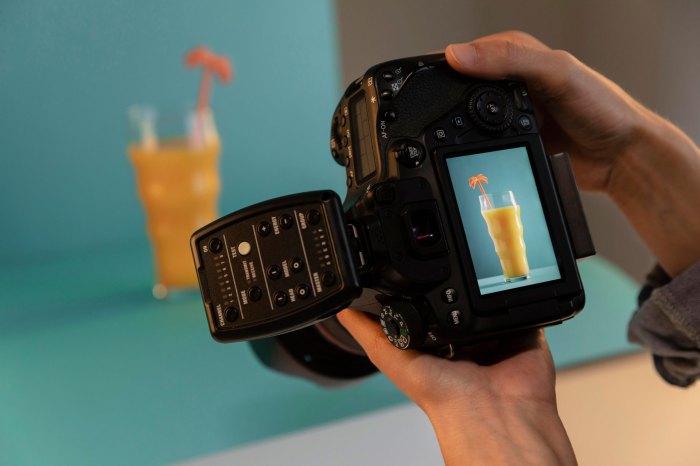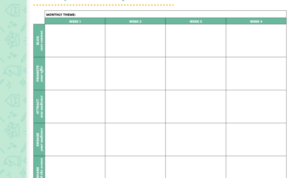E-commerce Product Photography sets the stage for online success, showcasing the art of capturing products with flair and finesse. Get ready to dive into the world of captivating visuals that drive sales and elevate brands.
From the importance of high-quality images to the equipment needed for a professional setup, this topic covers everything you need to know about mastering the art of E-commerce Product Photography.
Importance of E-commerce Product Photography

In the world of online shopping, high-quality product photography plays a crucial role in attracting customers and driving sales. When shoppers can’t physically touch or see a product in person, the images on an e-commerce website become their main point of reference. As a result, having visually appealing and detailed product photos is essential for creating a positive shopping experience and building trust with potential buyers.
Enhancing Brand Credibility and Sales
Professional product photography not only showcases your products in the best possible light but also helps to establish your brand’s credibility. When customers see clear, high-resolution images of your products, they are more likely to perceive your brand as trustworthy and reliable. This can lead to an increase in sales and customer loyalty over time.
- Amazon: The e-commerce giant is known for its high-quality product images that provide multiple views and detailed close-ups, allowing customers to make informed purchase decisions.
- Apple: The tech company’s sleek and visually appealing product photos have become synonymous with their brand identity, helping to drive sales and maintain a strong brand image.
- ASOS: The popular online fashion retailer invests in professional product photography to showcase their clothing and accessories in a way that resonates with their target audience, leading to continued success in the competitive e-commerce market.
Types of E-commerce Product Photography
When it comes to showcasing products online, different types of product photography play a crucial role in attracting customers and driving sales. Let’s dive into the various types commonly used in e-commerce.
White Background Product Photography
White background product photography involves capturing the product against a clean, white backdrop. This type of photography is ideal for showcasing the details and features of the product without any distractions. It helps create a professional and consistent look across all product images on an e-commerce website, making it easier for customers to focus on the product itself.
Lifestyle Product Photography
Lifestyle product photography showcases the product in real-life settings or scenarios, demonstrating how the product can be used in everyday life. This type of photography helps customers envision themselves using the product, making it more relatable and appealing. Lifestyle images are effective for creating a connection with the target audience and highlighting the benefits of the product in a practical context.
Infographic Product Photography
Infographic product photography involves using graphics, text, and visual elements to convey information about the product in a clear and engaging manner. Infographics can include features, specifications, size comparisons, or usage instructions, providing valuable details that may not be easily captured in traditional images. This type of photography is effective for highlighting key selling points and differentiating the product from competitors.
Importance of Consistency in Product Image Style, E-commerce Product Photography
Maintaining consistency in product image style across an e-commerce website is essential for establishing a strong brand identity and enhancing the overall shopping experience for customers. Consistent image style helps build trust and credibility with customers, as they can easily recognize products from the same brand. It also creates a seamless browsing experience, allowing customers to navigate the website effortlessly and make informed purchasing decisions.
Equipment and Setup for E-commerce Product Photography
When it comes to capturing high-quality product images for your e-commerce store, having the right equipment and setup is crucial. From cameras to lighting and backdrops, each component plays a significant role in creating professional-looking product photos that attract customers.
Essential Equipment for E-commerce Product Photography
- Camera: Invest in a DSLR or mirrorless camera with a high resolution for detailed product shots.
- Lighting: Use a combination of natural light, softboxes, or ring lights to eliminate harsh shadows and create even lighting.
- Backdrop: Choose a clean, neutral-colored backdrop to make your products stand out without distractions.
- Tripod: Keep your camera steady and ensure sharp images by using a tripod, especially for close-up shots.
Setting up a Budget-Friendly Product Photography Studio
Creating a basic product photography studio at home doesn’t have to break the bank. Here are some tips to set up a budget-friendly studio:
- Find a well-lit area near a window to take advantage of natural light.
- Use white foam boards or fabric as inexpensive backdrops for a clean and professional look.
- DIY softboxes with white fabric or paper lanterns can help diffuse light and reduce harsh shadows.
- Position your camera on a stable surface or tripod to avoid camera shake and ensure sharp images.
Tips for Achieving Professional-Looking Product Photos at Home
To take your product photography to the next level and achieve professional-looking results at home, consider the following tips:
- Experiment with different angles and perspectives to showcase your products from unique viewpoints.
- Focus on proper composition and framing to highlight the key features of your products effectively.
- Use editing software like Adobe Photoshop or Lightroom to enhance colors, remove imperfections, and make your photos pop.
- Consistency is key – maintain a cohesive look across all your product images for a polished and professional online store.
Editing and Retouching E-commerce Product Photos

Post-processing plays a crucial role in enhancing product images for e-commerce platforms. It helps in making the products look more appealing and professional, which can lead to increased sales and customer engagement.
Common Editing Techniques
- Background Removal: Removing the background of the product image to create a clean and distraction-free look.
- Color Correction: Adjusting the colors to make the product look true to life and visually appealing.
- Image Resizing: Resizing the image to fit the requirements of the e-commerce platform without compromising quality.
Tools and Software Recommendations
- Adobe Photoshop: A powerful tool for advanced editing and retouching of product photos.
- Lightroom: Ideal for batch editing and color correction of product images.
- Canva: Great for beginners and offers easy-to-use tools for basic editing and design.
Best Practices for E-commerce Product Photography
When it comes to showcasing your products online, high-quality images play a crucial role in attracting customers and driving sales. Here are some best practices to keep in mind for e-commerce product photography:
Creating Visually Appealing Product Images
- Use proper lighting to highlight the details of the product and avoid harsh shadows.
- Choose a simple, clutter-free background to keep the focus on the product itself.
- Capture multiple angles and close-up shots to give customers a comprehensive view of the product.
- Show the product in use or in context to help customers visualize how they can benefit from it.
Importance of Image Optimization
Optimizing your product images is crucial for faster loading times on e-commerce websites, which can significantly impact user experience and conversion rates. Here are some tips for image optimization:
- Compress images without compromising quality to reduce file size and improve loading speed.
- Use descriptive filenames and alt text to improve and accessibility for visually impaired users.
- Choose the right file format (JPEG for photographs, PNG for graphics) to balance quality and loading speed.
Creating a Consistent Look and Feel
Maintaining a consistent visual style across your product images is essential for branding and creating a cohesive online shopping experience. Here’s how you can achieve a consistent look and feel:
- Establish brand guidelines for photography, including colors, angles, and styling to maintain a cohesive brand identity.
- Use the same background and lighting setup for all product photos to create a uniform look on your website.
- Ensure consistent editing and retouching techniques to maintain a professional and polished appearance across all images.






